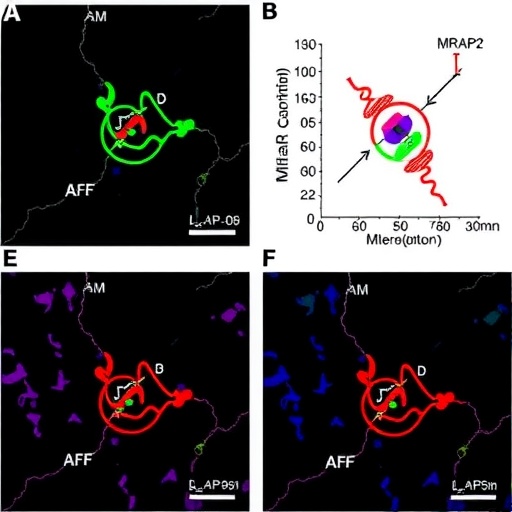In a groundbreaking study published in the Journal of Translational Medicine, a team of researchers has illuminated a critical pathway involving SH3BP5 that bridges metabolism and immune responses, particularly in diffuse large B-cell lymphoma (DLBCL). This comprehensive investigation not only identifies SH3BP5 as a potential prognostic biomarker but also positions it as a therapeutic target that may pave the way to refreshing the disrupted immune landscape characteristic of many cancers.
The research begins by addressing the pressing need for novel strategies in treating DLBCL, one of the most prevalent forms of non-Hodgkin lymphoma. With current treatment modalities offering limited success, especially in advanced stages, the researchers undertook the task of elucidating how tumor microenvironments can be recalibrated to enhance anti-tumor immunity. The role played by immune cells and the metabolic alterations within the tumor microenvironment is central to this ongoing quest for therapeutic efficacy.
The team employed a range of cellular and animal model systems to evaluate the impact of SH3BP5 on various immune signaling pathways. The results are striking, showing that SH3BP5 not only impacts the metabolic pathways within tumor cells but also modifies the immune cell activity in such a way that enhances tumor-killing responses. This dual effect—emanating from a single mediator—opens up fascinating avenues for combined metabolic and immune interventions in cancer therapy.
One of the striking aspects of their findings is the delineation of the mechanisms through which SH3BP5 affects immune cell functionality. By engaging key metabolic enzymes and pathways, SH3BP5 appears to create an environment conducive to sustaining immune responses against malignant cells. The breakdown of this process showed the researcher team how fine-tuning metabolic pathways could significantly enhance T-cell function while limiting the immune evasion tactics employed by tumors.
A notable component of the study reveals a shift in the balance between effector T-cells and regulatory T-cells in SH3BP5-high tumors. The interplay between these two cell types is critical, as effector T-cells are responsible for direct tumor attack, while regulatory T-cells often serve to suppress such immune responses. By skewing this balance, SH3BP5 may very well represent a promising target to elevate anti-tumor responses while mitigating the effects of immunosuppression—a hallmark of advanced cancers.
This research lays the groundwork for subsequent trials aimed at manipulating SH3BP5 activity in patients. By developing inhibitors or enhancers of SH3BP5, we can foresee a new line of treatment that not only targets the tumor cells directly but also bolsters the body’s natural immune defenses. Such strategies could be game-changers in oncology, particularly for DLBCL patients with poor prognosis.
In addition to DLBCL, the implications of SH3BP5-mediated metabolic-immune crosstalk could extend to a host of other malignancies where metabolic reprogramming plays a critical role. Given that cancer cells often exploit metabolic pathways for growth and survival, understanding how these signaling networks interface with immune responses might unveil universal therapeutic targets.
Moreover, the collaborative nature of this research underscores the importance of interdisciplinary approaches in tackling complex diseases. Combining insights from immunology, metabolism, and cancer biology, the authors emphasize how the future of oncology may rely heavily on a systems biology perspective. This paradigm shift necessitates the integration of various scientific disciplines to provide a holistic view of cancer progression and treatment.
As the study advances to the potential clinical translations, the authors call for collaborative efforts across academic institutions and pharmaceutical companies. Engaging a broad array of stakeholders including clinicians, basic science researchers, and industry partners will be essential in bringing these promising discoveries to the clinic. The journey from laboratory bench to patient bedside is fraught with challenges, but the potential for improving patient outcomes in DLBCL is a compelling motivator.
This research also places a significant emphasis on the need for biomarker-driven strategies in oncology. The identification of SH3BP5 as a prognostic factor brings to light the crucial role that precise biomarkers can play in tailoring individual treatment regimens. The future of cancer therapy may lie in our ability to harness these biomarkers to classify tumors more accurately and predict patient responses to specific therapies.
In conclusion, the study led by Wu et al. represents a significant step forward in understanding the dual role of SH3BP5 in DLBCL. By bridging metabolic and immune pathways, this research not only sheds light on the complexities of the tumor microenvironment but also opens new avenues for targeted therapy. As oncologists and researchers alike look toward the future, the potential of reshaping immunosuppressive environments through metabolic mediators like SH3BP5 stands as a hopeful beacon in the fight against cancer.
This ongoing exploration into SH3BP5’s contribution to metabolic-immune interactions is poised to inspire further research, leading to innovative therapies that can potentially transform clinical outcomes for patients afflicted by DLBCL and other malignancies with similar immune evasion characteristics. As data continues to emerge, we can only anticipate the profound implications that these findings will have in the development of future cancer treatments, ultimately providing a lifeline to those battling this challenging disease.
Subject of Research: SH3BP5-driven metabolic-immune crosstalk in DLBCL
Article Title: SH3BP5-driven metabolic-immune crosstalk in DLBCL: a prognostic biomarker and therapeutic target for reshaping immunosuppressive microenvironment.
Article References:
Wu, T., Yang, Y., Zong, Y. et al. SH3BP5-driven metabolic-immune crosstalk in DLBCL: a prognostic biomarker and therapeutic target for reshaping immunosuppressive microenvironment. J Transl Med 23, 1003 (2025). https://doi.org/10.1186/s12967-025-06951-z
Image Credits: AI Generated
DOI:
Keywords: DLBCL, SH3BP5, metabolic pathways, immune responses, prognostic biomarker, therapeutic target, cancer therapy.




